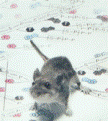Papers in the Biological Sciences

Jay F. Storz Publications
Document Type
Article
Date of this Version
2010
Abstract
Background: Elevated blood O2 affinity enhances survival at low O2 pressures, and is perhaps the best known and most broadly accepted evolutionary adjustment of terrestrial vertebrates to environmental hypoxia. This phenotype arises by increasing the intrinsic O2 affinity of the hemoglobin (Hb) molecule, by decreasing the intracellular concentration of allosteric effectors (e.g., 2,3-diphosphoglycerate; DPG), or by suppressing the sensitivity of Hb to these physiological cofactors.
Results: Here we report that strictly fossorial eastern moles (Scalopus aquaticus) have evolved a low O2 affinity, DPG-insensitive Hb - contrary to expectations for a mammalian species that is adapted to the chronic hypoxia and hypercapnia of subterranean burrow systems. Molecular modelling indicates that this functional shift is principally attributable to a single charge altering amino acid substitution in the β-type δ-globin chain (δ136Gly→Glu) of this species that perturbs electrostatic interactions between the dimer subunits via formation of an intra-chain salt-bridge with δ82Lys. However, this replacement also abolishes key binding sites for the red blood cell effectors Cl-, lactate and DPG (the latter of which is virtually absent from the red cells of this species) at δ82Lys, thereby markedly reducing competition for carbamate formation (CO2 binding) at the δ-chain N-termini.
Conclusions: We propose this Hb phenotype illustrates a novel mechanism for adaptively elevating the CO2 carrying capacity of eastern mole blood during burst tunnelling activities associated with subterranean habitation.


Comments
BMC Evolutionary Biology 2010, 10:214; http://www.biomedcentral.com/1471-2148/10/214 © 2010 Campbell et al; licensee BioMed Central Ltd. This is an Open Access article distributed under the terms of the Creative Commons Attribution License (http://creativecommons.org/licenses/by/2.0), which permits unrestricted use, distribution, and reproduction in any medium, provided the original work is properly cited.